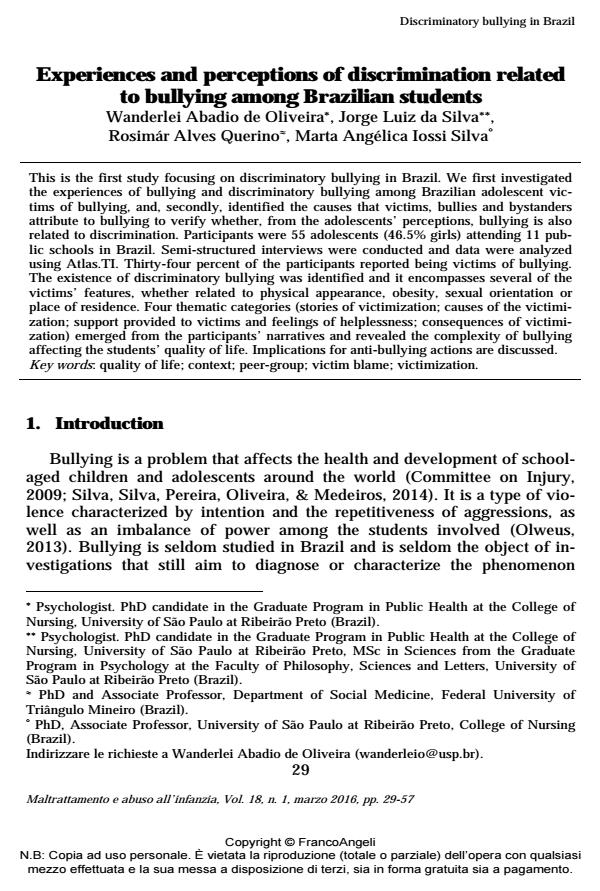Experiences and perceptions of discrimination related to bullying among Brazilian students
Titolo Rivista MALTRATTAMENTO E ABUSO ALL’INFANZIA
Autori/Curatori de Oliveira Wanderlei Abadio, Jorge Luiz da Silva, Querino Rosimár Alves, Silva Marta Angélica Iossi
Anno di pubblicazione 2016 Fascicolo 2016/1
Lingua Inglese Numero pagine 29 P. 29-57 Dimensione file 158 KB
DOI 10.3280/MAL2016-001003
Il DOI è il codice a barre della proprietà intellettuale: per saperne di più
clicca qui
Qui sotto puoi vedere in anteprima la prima pagina di questo articolo.
Se questo articolo ti interessa, lo puoi acquistare (e scaricare in formato pdf) seguendo le facili indicazioni per acquistare il download credit. Acquista Download Credits per scaricare questo Articolo in formato PDF

FrancoAngeli è membro della Publishers International Linking Association, Inc (PILA)associazione indipendente e non profit per facilitare (attraverso i servizi tecnologici implementati da CrossRef.org) l’accesso degli studiosi ai contenuti digitali nelle pubblicazioni professionali e scientifiche
This is the first study focusing on discriminatory bullying in Brazil. We first investigated the experiences of bullying and discriminatory bullying among Brazilian adolescent victims of bullying, and, secondly, identified the causes that victims, bullies and bystanders attribute to bullying to verify whether, from the adolescents’ perceptions, bullying is also related to discrimination. Participants were 55 adolescents (46.5% girls) attending 11 public schools in Brazil. Semi-structured interviews were conducted and data were analyzed using Atlas.TI. Thirty-four percent of the participants reported being victims of bullying. The existence of discriminatory bullying was identified and it encompasses several of the victims’ features, whether related to physical appearance, obesity, sexual orientation or place of residence. Four thematic categories (stories of victimization; causes of the victimization; support provided to victims and feelings of helplessness; consequences of victimization) emerged from the participants’ narratives and revealed the complexity of bullying affecting the students’ quality of life. Implications for anti-bullying actions are discussed.
Parole chiave:Quality of life; context; peer-group; victim blame; victimization.
- Skin color discrimination among primary school children Margherita Cardellini, in MALTRATTAMENTO E ABUSO ALL'INFANZIA 3/2018 pp.93
DOI: 10.3280/MAL2018-003006
de Oliveira Wanderlei Abadio, Jorge Luiz da Silva, Querino Rosimár Alves, Silva Marta Angélica Iossi, Experiences and perceptions of discrimination related to bullying among Brazilian students in "MALTRATTAMENTO E ABUSO ALL’INFANZIA" 1/2016, pp 29-57, DOI: 10.3280/MAL2016-001003